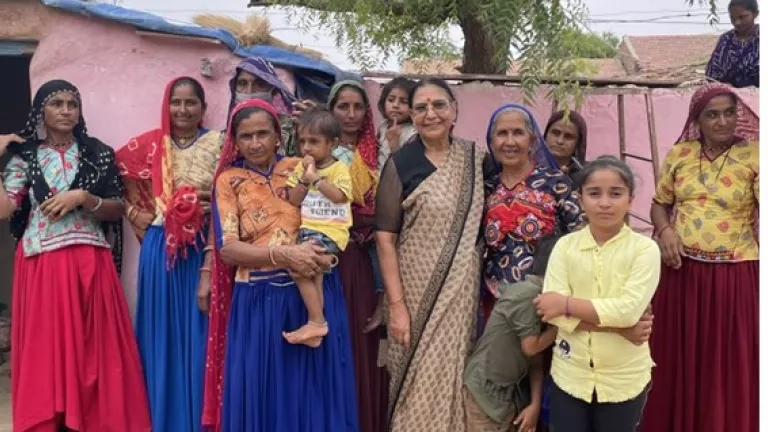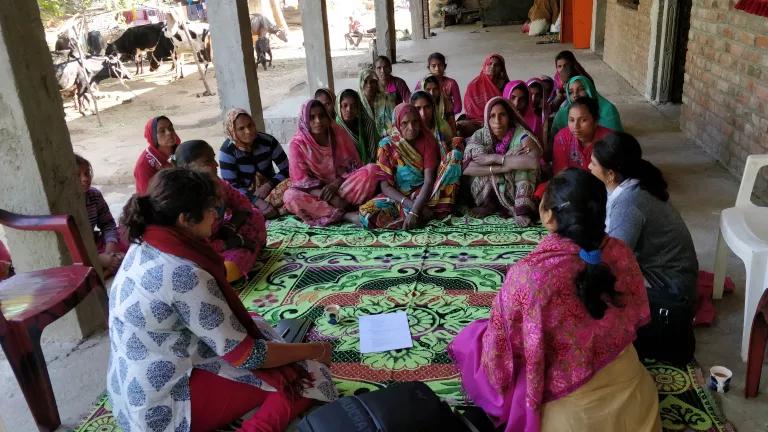Green Jobs for Gender Equality
As India continues to invest in green jobs, India has the chance to boost the representation of women in the renewable sector.

NRDC’s Amanda Maxwell, Managing Director of the International Program, and Sameer Kwatra, India Policy Director, with SEWA members, Rasnol Village, Anand District, Gujarat, India
NRDC
Guest blog by Akanksha Golchha
Countries around the world affirmed their commitment to gender equality and empowering women as agents of change in the clean energy transition at the G20 Energy Transitions Ministers’ Meeting in Goa, India. While India’s focus on green technology and green growth attracts both public and private investments, it also translates to employment opportunities for millions of professionals. This provides a unique opportunity to leverage the growth in the renewable energy sector to create a more gender-balanced and equitable future workforce, advance a just energy transition and help accomplish sustainable development goals.
As India continues to invest in green jobs, India has the chance to boost the representation of women in the renewable sector. Representation for women remains low in India due to multi-dimensional challenges including limited training in science, technology, engineering and management, lack of suitable job opportunities and flexibility, safety and security concerns, and societal challenges. Women are marginally better represented in the designing and pre-construction phases of renewable energy deployment as compared to construction and operations phases. Women have also been moderately more represented in segments such as distributed renewable energy (DRE) which are usually installed within or closer to home and depending on their use have immense job creating and entrepreneurship potential. Investing in DRE and local solutions where women are already more prevalent can help bridge the gender gap in renewable energy jobs.

A solar engineering trainer working on a solar lamp at a 'Barefoot College' in the village of Tiloniya, India
Gaganjit Singh/UN Women, CC BY-NC-ND 4.0
Key Steps to Achieving Gender Parity in the Clean Energy Transition:
Creating a Gender-Focused Skill Ecosystem: Developing a skill ecosystem with targeted gender-specific strategies can provide women with the necessary expertise to participate in the renewable energy sector. A skill ecosystem can comprise of multiple factors such as online or in-person trainings, access to materials and mentors, with a larger objective of empowering women to participate in livelihood opportunities.
Women entrepreneurs associated with SEWA in Rasnol Village in Anand District of Gujarat, India – a Hariyali Gram – have also reiterated the central role skilling plays in scaling up women’s involvement in the employment opportunities generated by the renewable energy sector. For instance, SEWA has been working with its members facilitate their training as technicians, plant operators, book keepers, and more through its various initiatives. Avenues such as online courses in local languages and career guidance can equip women with the necessary skills and knowledge required for active participation in the renewable energy workforce. By providing training and knowledge transfers, community members can confidently operate and maintain the technologies, ensuring their long-term success. Written materials can supplement online courses to facilitate capacity building on climate friendly solutions, empowering communities at the grassroots level. Through collaboration and capacity building, women entrepreneurs can become the change agents for renewable energy adoption and climate change—as demonstrated by SEWA's work with interventions such as Hariyali Gram.
- Foster Home-Based Livelihood Opportunities: Due to existing societal norms, women are often the primary caregivers—a role which can require more time and work at home. Strategically designed training programs focused on entrepreneurship can enable women to actively engage in home-based livelihood opportunities. For example, selling high quality fodder in the market that is grown using solar fodder systems at home can help provide more flexibility for women entrepreneurs who also have caregiving responsibilities. The development of these opportunities will require careful mapping of social and geographical factors such as access to market and transportation facilities to ensure smooth functioning of these enterprises. Adoption of climate friendly solutions, when used for productive purposes, has the potential to broaden the livelihood opportunities that can pave way for more holistic development in the rural areas with particular benefit to communities and women.
- Community and gender centric interventions: Policies, innovations, and investments designed with communities and gender-specific issues in mind can help. These can range from highlighting technologies that are easily operable by women to designing financing mechanisms that encourages women to participate in the formal credit system by addressing barriers to access finance. These interventions can, in turn, support the creation of appropriate ecosystems to empower women and communities. Productive use opportunities available from climate friendly solutions can help communities thrive financially while ushering India into a greener, sustainable, and equitable future.
As India continues to advance its climate and net-zero goals, comprehensive policy and market solutions that address energy poverty and enhance livelihood opportunities in rural areas are key. By creating enabling work environments and fostering gender balance, India can seize an unparalleled opportunity to lead by example. Integrating women as intrinsic stakeholders in the clean-energy transition is not only a testament to India's climate commitment but a crucial step towards combating climate change and achieving a more equitable society.
Akanksha Golchha is the Lead- Clean Energy and E-Mobility with NRDC India




